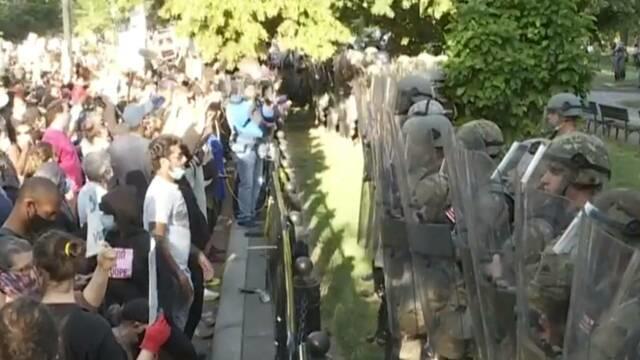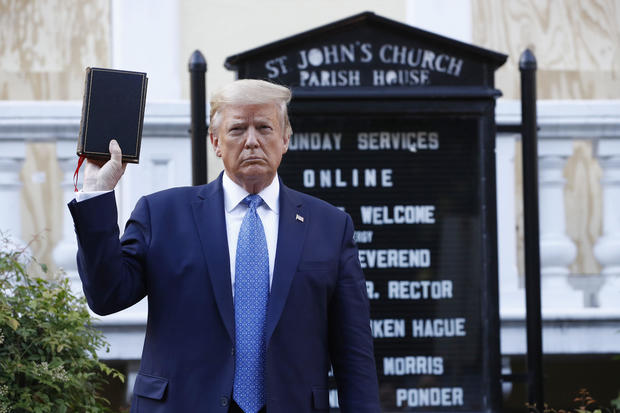Washington — The Interior Department’s inspector general said in a report released Wednesday that evidence it obtained “did not support a finding” that federal authorities forcibly cleared protesters from Lafayette Park last year so then-President Trump could walk from the White House and pose for a photo outside the historic St. John’s Church.
The watchdog, which examined the incident that occurred June 1, 2020, during protests against racial injustice and police brutality in Washington, D.C., instead found the U.S. Park Police had the authority to clear the park and surrounding areas, and did so to allow a contractor to install anti-scale fencing after several nights of violent clashes. U.S. Park Police also did not know that Mr. Trump would potentially be leaving the White House and crossing Lafayette Park until “mid-to late afternoon” on June 1, hours after the contractor had arrived to begin installation, according to the report.
“The evidence we obtained did not support a finding that the USPP cleared the park to allow the president to survey the damage and walk to St. John’s Church,” the report from the Interior Department’s inspector general states.
The watchdog further found that U.S. Park Police used a “sound amplifying long-range acoustic device” to issue three warnings telling the crowd to disperse, though acknowledged not all could hear the warning, and some police units began moving to clear protesters before the third and final warning was given. Additionally, the report states there were communication issues between U.S. Park Police and law enforcement agencies brought in to assist during the demonstrations, which were sparked by the death of George Floyd in Minneapolis.
“We found that the USPP and the Secret Service did not use a shared radio channel to communicate, that the USPP primarily conveyed information orally to assisting law enforcement entities, that an assisting law enforcement entity arrived late and may not have received a full briefing on the rules of engagement, and that several law enforcement officers could not clearly hear the incident commander’s dispersal warnings,” the report says. “These weaknesses in communication and coordination may have contributed to confusion during the operation and the use of tactics that appeared inconsistent with the incident commander’s operational plan.”
In a statement, Mr. Trump claimed the inspector general “totally exonerat[ed] me.”
“As we have said all along, and it was backed up in today’s highly detailed and professionally written report, our fine Park Police made the decision to clear the park to allow a contractor to safely install antiscale fencing to protect from Antifa rioters, radical BLM protestors, and other violent demonstrators who are causing chaos and death to our cities,” he said.
Mr. Trump was condemned for the incident on June 1, 2020, during which law enforcement officers used pepper balls and chemical irritants to disperse the crowd of protesters gathered in Lafayette Park, located outside the White House, just before the city’s 7 p.m. curfew took effect.
Shortly after the area was cleared, Mr. Trump, flanked by some members of his Cabinet and White House staff, walked across the park to St. John’s Church, a part of which had been set on fire the prior night.
The then-president delivered brief remarks outside the church and then held up a Bible as photos of the impromptu visit were taken.
Then-Attorney General Bill Barr said the protesters were removed from the park to expand the security perimeter around the White House, a move that was planned before Mr. Trump decided to walk through the area.
Video footage and news reports from June 1 raised questions about the events leading up to Mr. Trump’s walk from the White House, as Barr was spotted speaking with the U.S. Park Police operations commander on the scene.
Asked about the exchange, the operations commander told the watchdog’s team he warned Barr the area was unsafe and asked him to move away from the crowd.
“The USPP operations commander said the attorney general asked him, ‘Are these people still going to be here when POTUS [President of the United States] comes out?'” according to the report. “The USPP operations commander told us he had not known until then that the president would be coming out of the White House and into Lafayette Park. He said he replied to the attorney general, ‘Are you freaking kidding me?’ and then hung his head and walked away. The attorney general then left Lafayette Park. The USPP operations commander denied that the attorney general ordered him to clear Lafayette Park and H Street.”
The incident commander with the Park Police told the inspector general’s office that he, too, was never informed of Mr. Trump’s specific plans or when he planned to leave the White house.
“It was just a, ‘Hey, here he comes.’ And all of a sudden I turn around and there’s the entourage,” the incident commander told investigators, as detailed in the report.
The Park Police’s acting police chief also said he did not know of Mr. Trump’s plans to visit St. John’s Church, though the incident commander told him the president might assess the damage at an unspecified time, according to the report.
Narrow in scope, the investigation from the Interior Department’s inspector general focused on the U.S. Park Police actions and did not examine individual uses of force by officers, which are at the center of ongoing lawsuits or separate investigations. The watchdog said its authority to obtain documents or statements from entities outside the Interior Department was limited, though the office received radio transmissions and other information from the Metropolitan Police Department and Arlington County Police Department, as well as videos from Secret Service observation cameras in the Lafayette Park area and documents from the agency.
The inspector general said the office did not seek to interview Barr, White House personnel, Federal Bureau of Prisons officers, or personnel from the Secret Service or Metropolitan Police Department.
The report recommended the U.S. Park Police develop a detailed policy laying out procedures for operations involving protests that may require the use of force and improve field communication procedures.
Interior Secretary Deb Haaland told Inspector General Mark Greenblatt in a letter last month that she is establishing a task force to review and improve its law enforcement programs.
“The challenges our officers face every day are many, and the need to coordinate closely across jurisdictions in a manner that promotes transparency, accountability and public trust is paramount,” she said.
The National Park Service and U.S. Park Police said they have taken steps to address both recommendations from the inspector general.



































